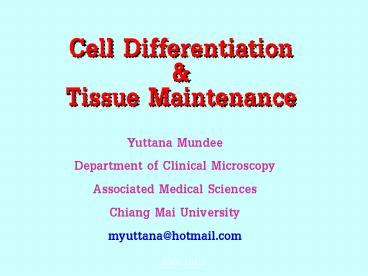Cell Differentiation PowerPoint PPT Presentation
1 / 24
Title: Cell Differentiation
1
Cell Differentiation Tissue Maintenance
- Yuttana Mundee
- Department of Clinical Microscopy
- Associated Medical Sciences
- Chiang Mai University
- myuttana_at_hotmail.com
2
Theory of Cell Differentiation
- Differential gene loss
- Selective gene amplification
- Genetic equivalence with differential gene
expression
3
Observation on Chromosomes
- Different cells from the same individual show the
same sets of chromosomes. - Polytene chromosomes of insects show the same
banding pattern in different tissue. - Chromosome elimination is associated with the
dichotomy between germ line and somatic cells.
4
Molecular Data on Genomic Equivalence
- Techniques in molecular biology have confirmed
the rule of genetic equivalence. - Selective gene expression and amplification are
found. - DNA excisions and rearrangements in B-lymphocytes
to produce enormous type of antibodies is
exception.
5
Totipotency of Differentiated Plant Cells
- New whole plants can be grown from several cell
types of differentiated plant cells. - Calluses, embryoids, growth factors, protoplasts,
hybrid protoplasts. - This indicates genetic equivalence in most of
plant cells.
6
Totipotency of Nuclei from Embryonic Animal Cells
- Nuclei from an animal cell can be developed to a
complete animal when implanted and nourished into
the cytoplasmic environment of an egg of that
animal.
7
Totipotency of Nuclei from Embryonic Animal Cells
(continued)
- Newt blastomeres develop normally after delayed
nucleation. - Nuclei from embryonic cells are still totipotent.
- Nuclei can be transferred by cell fusion.
8
Pluripotency of Nuclei from Differentiated Animal
Cells
- Nuclei from older donor cells show a decreasing
ability to promote the development of a new
organism. - Nuclei from mature cells are unprepared for the
fast mitotic cycles of early embryos.
9
Pluripotency of Nuclei from Differentiated Animal
Cells (continued)
- At least some differentiated cells contain highly
pluripotent nuclei. - Cells change their differentiated state during
regeneration. - Cells express different gene at different times.
10
Control of Nuclear Activities by the Cytoplasmic
Environment
- Gene expression changes upon transfer of nuclei
to new cytoplasmic environments. - Cell fusion exposes nuclei to new cytoplasmic
signals.
11
Conclusion and Outlook
- Most cells inherit complete and unaltered set of
chromosomes. - Chromosome loss or selective gene amplification
seem to be exceptions to the rule. - Loss, alteration or selective amplification of
genomic DNA are part of normal differentiation.
12
Maintenance of the Differentiated State
- Most differentiated cells remember their
essential character even in a new environment. - The differentiated state can be modulated by a
cellular environment.
13
Tissues with Permanent Cells
- The cells at the center of the lens of the adult
eyes are remnants of the embryo. - Most permanent cells renew their parts the
photoreceptor cells of the retina.
14
Reneval by Simple Duplication
- The liver functions as an interface between the
digestive tract and the blood. - Regeneration requires coordinated growth of
tissue components. - Endothelial cells line all blood vessels.
15
Reneval by Simple Duplication(Continued)
- New endothelial cells are regenerated by simple
duplication of existing endothelial cells. - New capillaries form by sprouting.
- Angiogenesis is controlled by growth factors
released from the surrounding tissues.
16
Reneval by Stem Cells Epidermis
- Stem cells can divide without limit and give rise
to differentiated progeny. - Epidermal stem cells lie in the basal layers.
- Different epidermal cells synthesize a sequence
of different keratins as they mature.
17
Reneval by Stem Cells Epidermis(Continued)
- Epidermal stem cells are a subset of basal cells.
- Basal cell proliferation is regulated according
to the thickness of the epidermis. - Secretory cells in the epidermis are secluded in
glands that have their own population kinetics.
18
Reneval by Pluripotent Stem Cells Blood Cell
Formation
- There are three main categories of white blood
cells granulocytes, monocytes and lymphocytes. - The production of each type of blood cells in the
bone marrow is individually controlled. - Bone marrow contains hematopoietic stem cells.
- Pluripotent stem cells gives rise to all blood
cells.
19
Reneval by Pluripotent Stem Cells Blood Cell
Formation (Continued)
- The number of specialized blood cells is
amplified by divisions of committed progenitor
cells. - The factors that regulate hemopoiesis can be
analyzed in culture. - Erythropoiesis depends on the hormone
erythropoietin.
20
Reneval by Pluripotent Stem Cells Blood Cell
Formation (Continued)
- Multiple CSFs influence the production of
neutrophils and macrophages. - Hemopoietic stem cells depend on contract with
cells expressing the stem cell (steel) factor. - The behavior of a hemopoietic cell depends partly
on chance. - Regulation of cell survival is as important as
regulation of proliferation.
21
Genesis, Modulation and Regeneration of Skeletal
Muscle
- New skeletal muscle cells form by the fusion of
myoblasts. - Muscle cells can vary their properties by
changing the protein isoforms that they contain. - Some myoblasts persist as quiescent stem cells in
adult.
22
Fibroblasts and Their Transformations the
Connective-Tissue Cell Family
- Fibroblasts change their character in response to
signals in the extracellular matrix. - The extracellular matrix may influence
connective-tissue cell differentiation by
affecting cell shape and attachment.
23
Fibroblasts and Their Transformations the
Connective-Tissue Cell Family (Cont.)
- Different signaling molecules act sequentially to
regulate production of fat cells. - Bone is continually remodeled by the cells within
it. - Osteoblasts secrete bone metrics, while
osteoclasts erode it.
24
Fibroblasts and Their Transformations the
Connective-Tissue Cell Family (Cont.)
- During development, cartilage is erode by
osteoclasts to make way for bone. - The structure of the body is stabilized by its
connective-tissue framework and by the selective
cohesion of cells.

